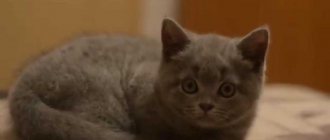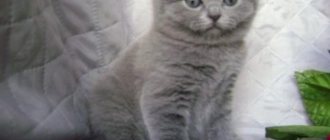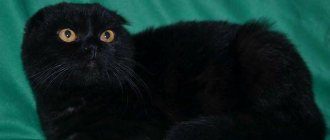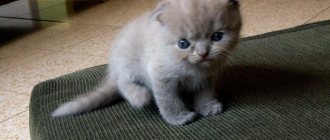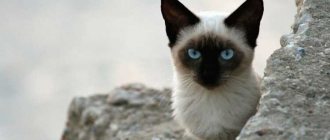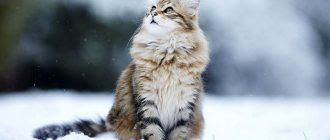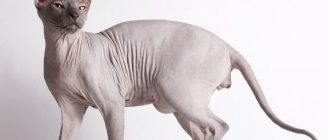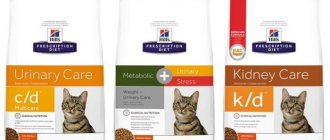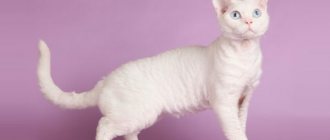Origin story
Two hairless breeds are recognized - the Don and Canadian Sphynxes.
The history of the Canadian breed began in 1966, when an ordinary cat in Canada gave birth to a hairless kitten. The baby was given the nickname Prune. He was crossed with his mother, resulting in both furry and hairless cubs. Prune continued to participate in matings with relatives. Hairless kittens were born weak, many died.
The history of the breed could have ended before it really began, but in 1975 a boy was born in the city of Waden, who was given the nickname Epidermis. Then a healthy bald girl was born. These individuals were sent to a nursery for breeding. Thus began the successful spread of the breed.
The history of Don cats is shorter. In 1986, Rostov resident Elena Kovaleva saw boys mocking a kitten. The woman drove away the hooligans and took the unfortunate animal home. The stress experienced was so strong that all the fur came out of the kitten, named Varvara. The treatment was unsuccessful.
Four years later, Varvara gave birth to hairless kittens from a short-haired cat. One of the cubs, the girl Chita, was taken for breeding by breeder Ira Nemykina. This cat became the ancestor of the Don Sphynxes. The breed was registered in 1996.
Canadian
This type of sphinx is over 60 years old.
Description of Canadian cats:
- dense skin covered with barely noticeable fluff;
- elongated head, straight nose;
- large and completely hairless ears;
- expressive eyes located at a slight angle;
- a strong body, with slight folds, and short front legs.
At the tip of the Sphynx's tail there is often a tuft of fur that remains throughout its life.
Breed varieties
Although the Don and Canadian Sphynxes are similar in appearance, they have different genetic origins. Among “Canadians,” the bald body gene is recessive, that is, in order to give birth to hairless babies, both the female and the male must be its carriers. In Don cats, the gene is dominant, so hairless kittens are born, even if one of the parents is furry.
Don Sphynx cats come in 4 coat varieties:
- bald;
- flock - with soft fur, similar to the touch, like peach skin, disappearing with age;
- velor – with wool up to 3 mm long;
- brush – with sparse and coarse hair.
Canadian cats are never completely hairless; their body is covered with soft, feather-like fur, which is slightly longer on the face, ears, tail and limbs.
Donskoy
The Don Sphynx was bred in Rostov-on-Don, known since 1980, and for a long time this variety was not classified as a Sphynx breed.
Distinctive features of the subspecies:
- toned body, long and thin legs;
- a large number of folds on the body;
- wide ears, rounded at the tip;
- short and thin neck, wedge-shaped head;
- medium, almond-shaped eyes.
Interesting! The peculiarity of Don Sphynx kittens is that they open their eyes within a few hours after birth.
Let's consider several types depending on the presence or absence of hair:
- hairless - the most exotic breed with bare skin;
- velor – at birth there is a velvet fluff on the body, which disappears by the age of 2;
- brush – the animal’s skin is covered with not long, but rough fur.
There are a large number of colors of the Don Sphynx, with the exception of chocolate and lilac.
Description of the breed
Both Canadian and Russian cats have an elegant physique, a neat muzzle, large eyes, soft, elastic, hot to the touch, covered with folds skin.
Interesting! The folding of the skin of the Don Sphynx is especially pronounced; the muzzle can be so wrinkled that the cat seems angry. Although modern selection is aimed at reducing folds.
Appearance and standards
The breed standard for the Sphynx is strict; a description of the appearance of Don and Canadian cats is given in the table.
| external sign | Canadian breed | Don breed |
| head | wedge-shaped, not elongated, with rounded contours | graceful, elongated, high cheekbones, wedge-shaped, with large eyebrows |
| eyes | large, round, with a slight slant, expressive look | large, almond-shaped |
| ears | disproportionately large, wide at the base, widely spaced | large, slightly tilted forward |
| vibrissae | short | short or curved, the hairless variety has no mustache |
| neck | short, strong | long, graceful |
| torso | medium-sized, harmoniously built, voluminous breasts | strong, sinewy, with well-developed muscles, wide chest |
| limbs | the front ones are longer than the back ones, sometimes slightly curved | medium length, graceful |
| tail | medium length, in some individuals the tip is decorated with a brush, like a lion's | medium length, straight, with rounded tip |
| weight | 3–6 kg | 4–7 kg |
Colors
The Sphynx breed comes in a variety of colors. Cats are:
- solid colors - black, white, red, blue, silver, lilac, brown (chocolate and cinnamon), cream;
- tabby - patterned (spotted, striped, marbled);
- bicolors - two-color;
- tortoiseshell – multi-colored with the obligatory presence of black and red;
- color point – Siamese color;
- calico - white color with black and red spots;
- Van – white color with slight cream-blue spotting.
The color of the iris is determined by the color, the pet can be green-eyed, yellow-eyed, blue-eyed. White sphinxes come with heterochromia - different eyes.
St. Petersburg
This species is considered quite young, the history of its appearance dates back to 1994. The kittens appeared as a result of selection of Don Sphynxes and Orientals, and the breed itself received official recognition in 2000.
Characteristic features of Peterbalds:
- elongated, muscular body and thin neck;
- eyes are medium-sized, almond-shaped, often colored green or blue;
- widely spaced ears;
- straight nose;
- wedge-shaped head;
- smooth skin without fur or with slight fluff;
- playful nature;
- strong attachment to the owner - the pet has a hard time withstanding prolonged loneliness.
The average weight of an adult cat is 3 kilograms, and a male cat is 4–5.5 kilograms. The pet's skin color can be blue, lilac, chocolate or cream. With proper care, the Peterbald Sphynx will live up to 16–17 years.
Note! The main disadvantage of the St. Petersburg cat is its predisposition to genetic diseases due to artificial breeding of offspring.
Character and behavioral characteristics
The Sphynx is a sociable cat, tightly attached to its owner, requiring constant attention. Loneliness for her is a disaster.
The character of sphinxes is kindness and tenderness, turning into pestering and importunity. Contact with the owner is so important for a cat that it can even interfere with his business. The pet's attitude towards strangers is friendly and welcoming.
Representatives of the breed willingly participate in children's games and are not inclined to bite or scratch. They get along with other cats and non-aggressive dogs without problems. The hunting instinct of sphinxes is poorly developed, so there is no need to worry about the fate of parrots and hamsters.
Personality Traits of Canadian Hairless Cats
Sphynx cats have a very kind, patient character and good attitude towards dogs. These cats can be left alone with children without worrying about both of them. They are not jealous, very patient and smart. Sphinxes often choose their favorite owner or even guest.
Male Sphynx cats tend to be dominant. They consider themselves masters of the house, independent and very curious. Any event does not pass by, any thing will be studied. Cats are softer and more gentle. They easily gain the trust and love of their owner. But the females need more attention to themselves and do not let you forget about their person: they will chase you and lick your face until they get tired. Female sphinxes are great lovers of cleanliness. They can lick themselves for hours. The completed washing procedure can be repeated after 2–3 hours.
Many people think that Canadians are very aggressive. But this is a mistaken opinion. My parents have a Canadian Sphynx. And he is very friendly, active and not afraid of strangers. Sphinxes have developed intelligence.
You can leave the Canadian Sphynx with the child
Positive qualities and disadvantages of the breed
Like any animal, the Canadian Sphynx has both positive and negative properties.
The positive qualities include the fact that they:
- playful;
- active;
- curious;
- tender;
- affectionate to the owner;
- get along well with other animals;
- patient;
- smart;
- love children.
And the negative qualities are as follows:
- they need daily care and frequent bathing;
- afraid of the cold;
- may seem intrusive.
Video: interesting facts about the Canadian Sphynx
Care and maintenance
Sphynxes are heat-loving indoor pets; you shouldn’t take them out for walks, otherwise you can’t avoid catching a cold. The cat's place in the house should be removed from heating sources and protected from drafts. If your home is cool, you should insulate your cat's body with a soft cat sweater.
Attention! Sphynxes love to lie in the sun. But prolonged sunbathing is unacceptable; a burn may remain on the delicate skin.
Hygiene rules
Bath the Sphynx cat with zoo shampoo for hairless breeds. The owner decides how often to bathe, but usually once every 1–2 months, when the body begins to emit an unpleasant odor. Hairless pets tend to sweat excessively. If you ignore bathing, you will have to clean the furniture from brown discharge left by the animal’s skin.
The hairless sphinx's eyes lack eyelashes, which is why discharge often appears on the tear ducts. They need to be removed daily with a cloth moistened with boiled water.
The ears are cleaned with cotton wool soaked in veterinary ear lotion. The claws are shortened with a nail clipper, being careful not to touch living tissue. The procedure is carried out once every 3 weeks.
Education and training
Sphinxes have high intelligence, they are understanding, obedient and obsequious. Therefore, training a litter box, the rules of behavior and hygiene is not difficult.
A one-year-old kitten can be taught to follow simple commands: “come to me,” “give me,” “sit.” Training should take place in a playful way, and positive results should be reinforced with treats and affection.
It is strictly forbidden to be rude and aggressive in raising a Sphinx. The pet is touchy and will forever remember cruel treatment.
What to feed the Sphynx
The best option for feeding the Sphynx is store-bought super premium or holistic food. It is advisable to choose a product designed for hairless cats.
If the cat eats natural food, then the diet should include:
- meat and offal;
- cereal porridge;
- eggs;
- vegetables;
- fermented milk products.
Important! Due to their fast metabolism, sphinxes are gluttonous; the daily portion of food for them is 2 times more than for ordinary cats. But overfeeding is unacceptable; it poses a great health hazard.
You can't feed the sphinx:
- fatty meat;
- fried foods;
- salinities;
- smoked meats;
- sweets;
- spices;
- bakery products;
- waste from the master's table.
How hairless cat breeds were developed
Felinologists still cannot figure out which hairless cat was the very first. The thing is that they were ignored by breeders for a long time. Mentions of hairless pets are found among the Aztecs and Egyptians, so it is logical to assume that the mutant gene for hairlessness existed before our era.
Breeding work to consolidate the unusual trait began only in the second half of the 20th century. Scientists have found that the gene responsible for hairlessness is dominant. Thanks to this, it was easily preserved naturally and did not sink into oblivion.
Sphynx kittens
You should buy a kitten from a reputable cattery. The seller must draw up a sales contract, provide the buyer with a veterinary passport indicating the vaccinations performed and a metric on the basis of which a pedigree can be requested.
Breeding
Crossing the Don and Canadian Sphynxes is prohibited. You cannot breed two completely hairless individuals, even of the same breed, as the cubs will not be viable.
Males mature at 8 months. The first estrus in females is observed at 6–7 months and proceeds rapidly. The Sphynx girl meows at the top of her lungs and behaves nervously and fussily. But you can’t knit at an early age, it will negatively affect the offspring and the health of the parents. Both the male and the female must be one and a half years old.
Vaccinated and healthy animals checked by a veterinarian are bred. Their claws are trimmed to prevent accidental injuries. The cat is taken to visit a gentleman and left for a couple of days.
Pregnancy lasts 63–65 days. Childbirth usually occurs without complications and human assistance is not needed. There can be up to 12 cubs in a litter.
Price
The cost of a representative of the breed is determined by pedigree and exhibition category. A pet-level pet (companion) can be bought for at least 5 thousand rubles. And the cost of breed kittens (for breeding) and show-level kittens reaches 100 thousand rubles.
How to choose the right one
When choosing a kitten, pay attention to the following signs of a healthy animal:
- affectionate, playful, active, friendly behavior (if the kitten is angry and fearful, then he is being mistreated or has mental problems);
- moderately well-fed body;
- clear teardrops of the eyes;
- ears and anus without discharge;
- skin without signs of dermatitis.
How to care in the first months
A kitten is purchased when it is 3 months old; at this age it already knows how to use a litter box and is vaccinated. The breeder is obliged to tell the buyer how to care for the pet. It is worth getting a phone number from the breeder so you can call if you have questions.
You should ask the breeder what food the kitten was fed in the nursery. The transition to another diet should be smooth so that the pet’s digestion is not disrupted.
The purchased kitten is taught to bathe and other hygienic procedures. Up to six months they feed 6 times a day, up to a year - 3 times, then - 2 times.
Features of caring for hairless cats
Caring for Canadian Sphynx cats does not involve anything special or difficult. Bathing, cleaning ears and eyes, and trimming nails should be regular.
In the cold season, you need to dress the sphinx in warm clothes and monitor the temperature in the room.
Due to the lack of hair, Sphynx cats are often cold and can catch a cold in a draft, so you should take care of special clothes for them.
Bathing
Sphynxes should be bathed as their skin becomes dirty and as rarely as possible. Too frequent procedures can lead to excessive dryness of the skin, and too infrequent procedures can lead to clogged pores, accumulation of secretions in the folds of the skin and, as a result, skin diseases. In summer, the animal is bathed no more than once a week, and in winter - when dirty.
Shampoo for hairless pets should be hypoallergenic, with a neutral pH of 5.5. It is advisable to purchase a detergent designed specifically for sphinxes:
- Ms.Kiss “Graceful Sphinx”;
Shampoos developed for hairless cats take into account the characteristics of the animal’s skin.
- "Elite professional" from "Agrovetzaschita".
The water for bathing should be quite hot: about 37–38˚С. Swimming in cool water often leads to colds. After the procedure, you need to wipe your pet with a dry soft towel. You cannot blow dry cats of this breed, as the skin will react negatively to dry hot air. The temperature in the room after water procedures should be no lower than 25˚C. Otherwise, the animal may catch a cold.
Caring for ears, eyes, claws
It is necessary to carefully clean the ears with slightly damp cotton swabs as they become dirty. To prevent eye diseases, you need to clean your eyes once a week with a cotton pad moistened with boiled water or weak tea leaves. And also regularly (once every 10-14 days) cut the nails.
Typically, Sphynx cats do not resist when performing these simple actions. On the contrary, many of them love to lie with their owner in a warm bath and purr loudly when their nails are trimmed after bathing.
Video: how to care for the Canadian Sphynx
Toilet
Most often, a special plastic tray is used for the toilet. When purchasing it, make sure that the dimensions allow your pet to fit comfortably in it. It should be taken into account that when the kitten grows up, it is not advisable to change the toilet to which he is accustomed to a larger tray. You also need to correctly select the height of the sides of the litter tray. From a litter box with low sides, litter may spill out, and a tray with high walls may be uncomfortable for the kitten. It is advisable for the toilet to have a flat bottom. This gives it stability.
Diet of the Canadian Sphynx
Feed your pet only high-quality food and products. The Canadian Sphynx can be fed with both ready-made food and natural products.
Ready-made feed
Ready-made food can be dry or wet. Any of these species can be used to feed Sphynx cats. Some veterinarians recommend using a mixed type of feeding, when the cat's diet includes both dry and wet food. But other experts are opponents of this approach. In any case, it would be wise to consult with your veterinarian or the breeder from whom you are purchasing the kitten about what is best to feed your pet.
Economy class products are not suitable for feeding Canadian Sphynx cats. They are not able to meet the body's needs for essential substances and can even harm the pet's health. Therefore, it is necessary to buy only premium or super premium food. These include:
- HILLS (Hills);
- EUKANUBA (Ekanuba);
- EAGLE PACK (Eagle Pak);
- IAMS (Yams);
- ROYAL CANIN (Royal Canin);
The Royal Canin brand has dry food specially designed for Sphynx cats
- NUTRO CHOICE (Nutro choice);
- BOSH (Bosch);
- PRO NATURE (About Nature);
- PRO PLAN (Pro Plan);
- INNOVA (Innova);
- CHIKEN SOUP (Chicken soup);
- ACANA (Akana);
- ORIJEN (Origin).
Natural products
The diet of an adult Sphynx should include the following foods:
- lean meat;
- chicken kidneys and hearts;
- fish;
- cereal;
- vegetables;
- greens and fruits (if the animal does not mind this).
The following products are prohibited:
- fish bones;
- milk;
- raw river fish;
- chicken bones;
- salty foods;
- smoked meats;
- sweets;
- spicy foods.
A small kitten up to 1.5 months should be fed with mother's milk. Then the diet includes:
- cottage cheese;
- egg yolk;
- milk formulas;
- porridge.
From three months you can give:
- greenery;
- unsalted cheese;
- boiled lean beef;
- boiled vegetables;
- shredded chicken breast.
The power mode is as follows:
- from 1 to 3 months you need to feed the kitten 6–8 times a day, 20 or 25 g per feeding;
- from 4 to 6 months - 2-3 times a day, 40 or 50 g per feeding.
TOP 10 facts about sphinxes
Here is a brief summary of everything interesting about sphinxes:
- Hairless cats existed in ancient times. The Egyptians kept them in temples, and the Aztecs considered them healing animals.
- The ancient cats became extinct. And the living sphinxes are an artificial breed obtained as a result of a gene mutation.
- The average lifespan of cats is 14 years. But there are long-livers, reaching up to 17–19 years.
- The body temperature of the sphinx reaches 39 °C.
- Representatives of the breed love swimming in warm water.
- Sphynx cats are not hypoallergenic, despite their lack of fur. Their saliva contains the same amount of allergen protein as other breeds.
- Hairless cats love to sleep in the master's bed under the blanket. After all, this is the warmest place.
- A newborn kitten opens its eyes after 3-4 days.
- Sphynx cats have sensitive skin, so they love to be petted and caressed.
- Due to their increased metabolism, cats defecate 3 times more often than other breeds, and the smell of their feces is intense. Therefore, you have to clean the tray often.
What diseases are Sphynx cats susceptible to?
Sphynx cubs' eyes open much earlier than those of other breeds. In this regard, they are more likely to develop conjunctivitis (inflammation of the mucous membrane of the eyes). Signs of this disease are discharge from the eyes, which can be mucous or purulent. Treatment involves clearing the eyelids of secretions and instilling eye drops or applying ointment (tetracycline or hydrocortisone). To avoid aggravating the disease, treatment should only be prescribed by a veterinarian. To prevent this disease, it is recommended to cleanse the eyes daily using a cotton pad moistened with boiled water.
Canadian Sphynxes often suffer from mastopathy (an inflammatory process and pathological enlargement of the mammary glands with the appearance of seals on them). This disease can also occur in males who have been castrated. Most often, mastopathy is a consequence of a hormonal disorder, so self-medication when signs of the disease are detected is contraindicated. The symptoms of this disease are:
- swelling and hardening of the mammary glands;
- redness around the nipples;
- painful sensations in a cat when palpating the mammary glands.
Mastopathy is pathological changes in the mammary gland
Since Sphynxes do not have hair, their skin is prone to various allergic reactions, which can manifest themselves:
- redness;
- itching;
- the occurrence of dandruff;
- the appearance of ulcers on the skin.
The most common cause of allergies is the body's reaction to cleaning products, medications and food.
The average lifespan of Sphynx cats is 12–15 years.
Nutrition
Sphynx cats love to eat, and their tummies prove it. They are ready to eat anything you offer them. That is why you should pay close attention to their nutrition.
Sphynx cats have a high metabolism and a sensitive digestive system, so they thrive on small meals at regular intervals throughout the day. Serving food this way also prevents cats from becoming disinterested in eating.
Dry cat food helps clean your cat's teeth and protects gum health, but it's worth making sure your Sphynx has access to water to drink after eating to prevent dehydration. You can also purchase special treats at pet stores that help improve gum health.
Some Sphynx owners choose a raw food diet for their pets and claim numerous health benefits. They offer your pet raw fish - tuna or sardine - in addition to food and wet canned cat food.
Interesting Facts
For those interested in Sphynxes, here are a few facts about these cute cats:
- They have an excellent appetite, as their body quickly gives off heat.
- Hairless cats come in different colors and even patterns on their bodies in the form of spots or stripes.
- Although the Sphynx seems too hot, its body temperature is almost the same as that of representatives of other breeds, only 0.5 degrees higher.
- A hairless cat can easily learn to open door handles and perform other manipulations.
- The Canadian Sphynx is not suitable for allergy sufferers.
Prices for kittens, how to choose a nursery
Any purebred animals must be purchased from specialized nurseries. Otherwise, you risk getting a mixed breed or a sick kitten.
First, look at what hairless cats are offered in your city. A trip to the capital or another country may be necessary only if you choose the rarest and smallest variety. When searching for a suitable nursery, be sure to read reviews and do not hesitate to request documents confirming the legality of the activity.
Prices for naked kittens start from 6-10 thousand rubles. The total cost depends on:
- prestige and territorial location of the nursery;
- exterior quality;
- presence of pedigree;
- originality of colors;
- age and sex of the animal.
The most expensive are show-class kittens, which are purchased for participation in exhibitions. Their cost starts from 50-80 thousand and can reach 400 or more thousand rubles.
Health and breed diseases
Today's sphinxes have good immunity. Anyone can get sick, but in order to avoid suffering for the pet and wasting the owner’s nerves, vaccination should be carried out in a timely manner. According to the vaccination calendar, the first one is given at 8 months of age, then at a year and beyond.
The most common diseases of sphinxes are:
- Turning of the eyelids (entropion). It occurs quite often and does not occur in the mildest form. If you notice watery eyes, do not self-medicate and consult a specialist. This disease can lead to vision loss.
- Skin diseases. Due to the lack of fur, this breed is prone to dermatitis and acne.
- Gastrointestinal diseases and obesity. These problems can arise due to improper nutrition or overfeeding of the animal.
- Ear mite. Check your pet's ears periodically and notice if he scratches them excessively.
- Lichen. This disease is a common problem in hairless cats. Monitor the condition of your skin and if any foreign spots appear, consult a doctor.
Advantages and disadvantages
A hairless cat has many advantages, but there are also some disadvantages:
ProsCons
| Lack of fur | Need for careful care |
| Friendly disposition | Strong dependence on a person |
| High intelligence | Need for clothing (additional expenses) |
| Indiscriminate eating | High feed consumption |
| Good health | |
| A cat's ability to get along with other animals | |
| Underdeveloped hunting instinct | |
| Various color palette |
Owners of Sphynx cats speak of them with love and tenderness. They are often compared to dogs, because hairless pets follow their owner's heels and constantly climb into their arms.
A gentle and friendly creature with a non-standard appearance is ideal for both a lonely elderly person and families with small children.


